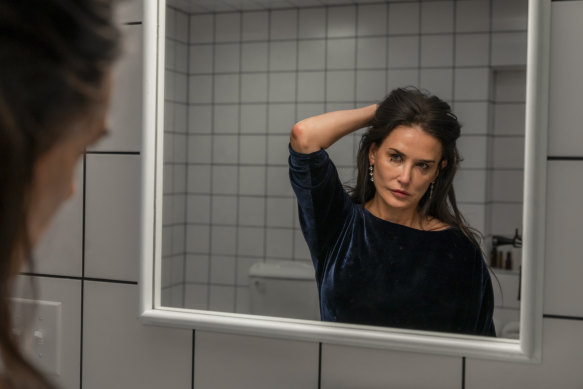This was published 4 months ago
Opinion
Why Demi Moore’s body-horror movie is so compelling, despite the truth it’s missing
Julia Baird
Journalist, broadcaster, historian and authorThe best line in the new movie The Substance, a gory, gaudy, body-horror feminist cautionary tale, is a question asked by the main character, Elisabeth Sparkle, played by Demi Moore. Sparkle is a glamorous television star, an aerobics instructor whose physical near-perfection is seemingly undermined by only one thing – her age.
She realises this when her boss, Harvey, a repulsive sleaze played deftly by Dennis Quaid, takes her to lunch and while beheading then eating prawns like a pig – the camera hones in on the spittle and sauce flying from his mouth, as we hear every salivary, open-mouthed chew – he informs her that “at 50, well, it stops”.

Demi Moore in a scene from The Substance.
A neatly groomed Moore stares at him: “What stops?” He demurs, flubs and leaves the table to talk to someone else. Indeed, what stops? Any time we see powerbrokers in this film they are old white men. It’s not over for them. Harvey himself is considerably older than Elisabeth – Quaid is 70 (though his fourth wife is 31). But Elisabeth is fired on her 50th birthday.
I was expecting to loathe this movie – all the talk of beauty standards, and the devaluing of women who, somehow, manage to grow older, just like men, seems endless, often fruitless. So often, efforts to decry the futility of women fighting ageing are cliched or end up holding up the whole stupid patriarchal idea anyway, so women end up feeling anxious and diminished, not enraged and enlarged.
After all, the star of this movie, Demi Moore, 61, is known for her beauty, her attempts to look young, her constant physical modifications and endless maintenance. She is playing a 50-year-old.
During the film I was periodically blocking my ears (every noise was heightened: the insertion of needles into flesh, feet slipping in blood, a cigarette being lit), groaning in disgust and laughing at the ridiculousness of the final scenes. Audience members have walked out, fainted and vomited. If you’re at all squeamish, it’s well avoided.
But at the end, I was full of admiration for the originality of French director Coralie Fargeat. The cinematography is crisp, the colours vivid, and the message is clear: in trying to defy our bodies lies the way of madness; poisonous ideas about the way women look lead us down dangerous paths of insatiability and dissatisfaction, and we are all complicit.
Here is the premise: Sparkle, desperate to maintain her status and defying ageing, gets sucked into taking a neon-green-glowing elixir of youth called The Substance, one that “unlocks DNA” and causes a younger version of her to exit her body (more gore, through the spine) and take up the job she was about to lose. The voiceover in the advertisement asks: “Have you ever dreamt of a better version of yourself – younger, more beautiful, more perfect?”
But the caveats are that Elisabeth and her younger self – Sue, who quickly becomes a TV star – need to take turns being in the world for a week, then being at home, rejuvenating for a week. Sue (played by Margaret Qualley) begins to take liberties, Elisabeth seeks revenge, and grotesquerie ensues. Elisabeth begins to dramatically age, resembling a furious, hairless, gnarled gnome. Demi Moore is fantastic.
Many have blasted the film. They are right to say that, in it, the female body is both exploited and made repulsive. There are countless close-ups of Sue’s sweaty breasts and perfectly round ass. And Elisabeth, once she feels ugly, old and washed-up, goes mad and becomes monstrous, a familiar trope known as hagsploitation.
I kept wondering how much The Substance cost, and if an addiction would bankrupt Elisabeth, but we never find out. The billions that women willingly, happily, repeatedly spend on often unevidenced anti-ageing treatments could fund entire economies. Men, too, under the guise of “looksmaxxing”.
American journalist Paula Froelich has detailed how this film captures the horror she feels at growing old, and enduring constant procedures, including burning skin and leaving slices of eyelids on surgeons’ floors. She writes in The Free Press: “I applaud The Substance because it does not sugarcoat … It depicts the bind in which women find ourselves: the pressure we’re under, the ghastly battle we wage daily with ourselves, and the horrific ways in which we torture our bodies and our minds in the search for youth, success, and acceptance.”

Illustration: Dionne Gain Credit:
I get it. But does this really reflect all of us? Does it have to be a ghastly battle? I’d like to propose another reading, one in which women pull wind into their lungs over a lifetime, iron into their spines, certainty into their gazes. There are many alternatives to the path of cutie to crone. Think of the glory of Marie Curie, Susan Sontag, Dorothea Lange, Mary Oliver, Judith Wright, Toni Morrison, Helen Garner, Nauiyu elder Miriam-Rose Ungunmerr-Baumann. Women who have understood what we think of the world is far more interesting than what it thinks of us. This film outlines the problem, but not the alternative.
‘It depicts … the ghastly battle we wage daily with ourselves, and the horrific ways in which we torture our bodies and our minds in the search for youth, success, and acceptance.’
Journalist Paula Froelich
This may be because, as Fargeat said in an interview, she believes beauty standards “somehow stay forever on your shoulder”. She says: “You can tame them. You can make them less loud. You can put them to sleep for some time, but they are still your strongest inner enemy that you have to deal with, and that’s what I wanted to show … the reality of how society still works and what we have to live with. To show how violent it is, but also to show how difficult it is to make that change on our own.”
Sigh. She wants women instead to know that, “If you don’t feel good, it’s not your fault; everything around you is responsible for making you feel like that. So, hopefully, if we see some change in society, it will help us all get out of this jail that we have built for ourselves.”
The timidity of this statement contrasts to the fury in the film. And the frustration of women who like to think and talk about something other than discussion of their own beauty, or lack thereof, or decay. Surely one way out is, if not to turn the mirror to the wall, to turn away from it.
I couldn’t help wondering if Elisabeth, instead of imbibing toxic liquid, perhaps needed a few good friends, who would be growing older alongside her, maybe a therapist, some books and definitely a hobby, something like ocean swimming? Something that forces her to stop looking at her reflection and start looking around her, at others, at the natural world, at the absurdity of things.
Because company makes everything endurable. Sit down with a group of close, banter-driven, loyal female friends and ask them about ageing: before long, probably within a minute, they will be roaring with laughter, wiping their eyes, raising their glasses and getting on with it.
Julia Baird is a journalist, author and regular columnist. Her latest book is Bright Shining: how grace changes everything.
Get a weekly wrap of views that will challenge, champion and inform your own. Sign up for our Opinion newsletter.